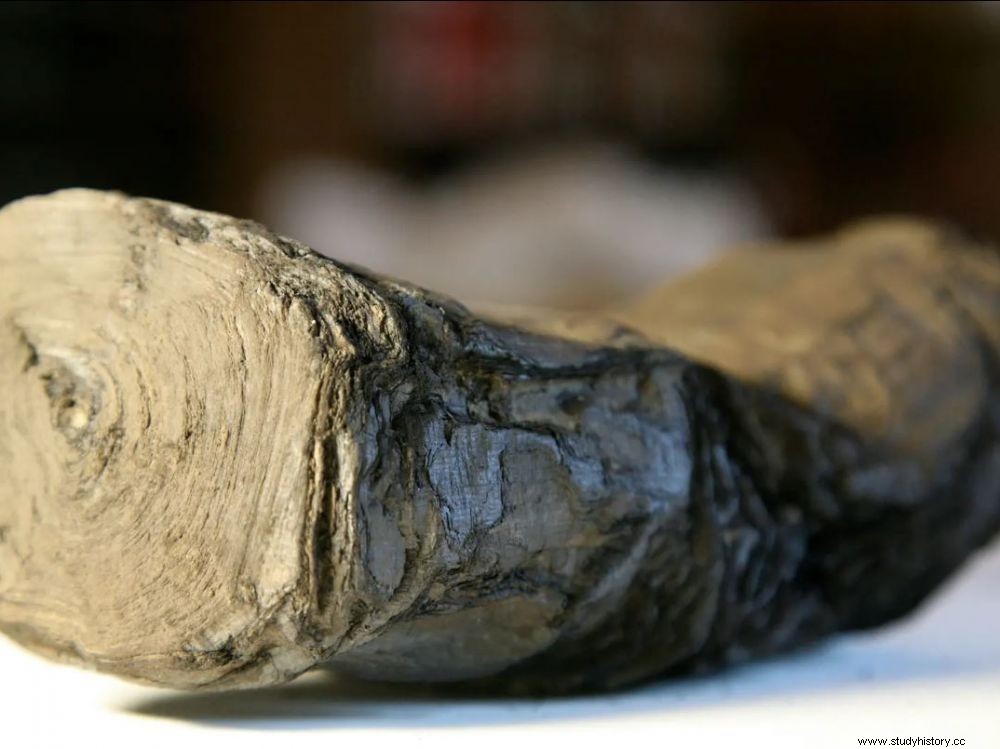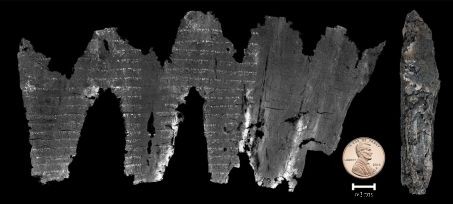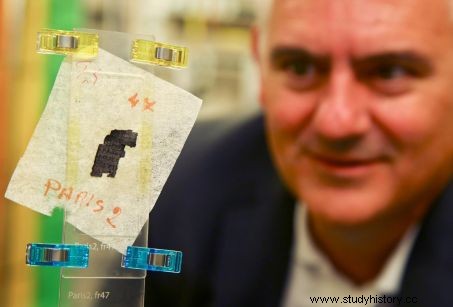2,000 years old, manuscripts of Herculaneum belonging to the Institut de France are currently being studied in England. The application of new non-invasive techniques could accelerate their decryption.

Digitization of one of the two rolls of Herculaneum from the Institut de France (Paris), at the Diamond Light Source, in England.
In the English countryside, the Diamond Light Source synchrotron located in the Oxford region, will it finally allow to "crack" the prestigious papyri of Herculaneum? These fragile scrolls, instantly carbonized during the eruption of Vesuvius (Italy) in 79 AD, are the only surviving treasures of the only library of Greco-Latin antiquity that has come down to us... Cooked by the heat of the flows of destructive mud and lava from the volcano, they escaped total annihilation, as they were never in contact with the flames. A boon that scientists are trying to exploit.
Thus, an international team of researchers believes that they are closer than ever to soon be able to "read", using non-invasive decryption techniques, two of these fragile 2000-year-old scrolls, which it is impossible to unwind without destroying them!
According to Brent Seales, director of the "Digital Restoration Initiative " from the University of Kentucky (United States), famous for having "read", after having reconstructed it digitally, one of the 1,700-year-old Hebrew manuscripts of Ein Gedi (Israel), an innovative association using X-rays energy, and Artificial Intelligence (AI), could help achieve these results.

Virtual unfolding of the charred manuscript of Ein Gedi, an ancient biblical manuscript, discovered in 1970 at Ein Gedi, southwest of the Dead Sea. ©Digital Restoration Initiative / University of Kentucky
In antiquity, scribes used an ink obtained from the residue of smoke or soot. A material whose composition is almost identical to that of charred papyri, is difficult to detect. "The contrast between the ink and the carbon is not very great. But with this machine and its powerful light source, we will be able to distinguish the writing", enthuses Laurent Chapon, director of physical sciences at the Diamond Light Source, who responded to AFP. "We project a very intense light through the roller [by rotating it 360° Editor's note], then let's detect a certain number of two-dimensional images on the other side. From this we reconstruct a three-dimensional volume of the object ... to read the text non-destructively ", he continued. These very high resolution 3D images are indeed made possible, thanks to the I12 beamline of the British synchrotron.
In the English countryside, the Diamond Light Source synchrotron located in the Oxford region, will it finally allow to "crack" the prestigious papyri of Herculaneum? These fragile scrolls, instantly carbonized during the eruption of Vesuvius (Italy) in 79 AD, are the only surviving treasures of the only library of Greco-Latin antiquity that has come down to us... Cooked by the heat of the flows of destructive mud and lava from the volcano, they escaped total annihilation, as they were never in contact with the flames. A boon that scientists are trying to exploit.
Thus, an international team of researchers believes that they are closer than ever to soon be able to "read", using non-invasive decryption techniques, two of these fragile 2000-year-old scrolls, which it is impossible to unwind without destroying them!
According to Brent Seales, director of the "Digital Restoration Initiative " from the University of Kentucky (United States), famous for having "read", after having reconstructed it digitally, one of the 1,700-year-old Hebrew manuscripts of Ein Gedi (Israel), an innovative association using X-rays energy, and Artificial Intelligence (AI), could help achieve these results.

Virtual unfolding of the charred manuscript of Ein Gedi, an ancient biblical manuscript, discovered in 1970 at Ein Gedi, southwest of the Dead Sea. ©Digital Restoration Initiative / University of Kentucky
In antiquity, scribes used an ink obtained from the residue of smoke or soot. A material whose composition is almost identical to that of charred papyri, is difficult to detect. "The contrast between the ink and the carbon is not very great. But with this machine and its powerful light source, we will be able to distinguish the writing", enthuses Laurent Chapon, director of physical sciences at the Diamond Light Source, who responded to AFP. "We project a very intense light through the roller [by rotating it 360° Editor's note], then let's detect a certain number of two-dimensional images on the other side. From this we reconstruct a three-dimensional volume of the object ... to read the text non-destructively ", he continued. These very high resolution 3D images are indeed made possible, thanks to the I12 beamline of the British synchrotron.
Machine learning algorithms will then attempt to use this data to decipher the contents of the scrolls, relying on the still visible ink present on the surface of four small papyrus fragments from Herculaneum.
"The tool we are developing will amplify the ink signal by teaching a computer algorithm to recognize it pixel by pixel from digital photographs ", explained Brent Seales, who hopes to be able to perfect this process over the next few months. A huge step forward in the ability to read and visualize the elusive texts of these "libraries" on which the recent American expert has been working for several years. recipient of a $2 million grant from the Andrew W. Mellon Foundation to continue this work…
"Which will allow us to immediately see the internal structure of the scrolls with more definition than ever before, and we need this level of detail to distinguish the highly compressed sheets on which the text rests." In 2016, Seales' team had developed a revolutionary program (Volume Cartographer), which makes it possible to locate and map 2D surfaces in a 3D object.

Brent Seales, director of the Digital Restoration Initiative at the University of Kentucky, in front of one of the papyrus fragments from Herculaneum (Italy), being analyzed at the Diamond Light Source synchrotron, in England. ©AFP
The English tests were carried out at the end of September 2019 on two intact papyrus scrolls from Herculaneum as well as the four fragments mentioned above. Preserved at the Institut de France, they had been offered in 1802 as a gift to the First Consul Napoleon Bonaparte by the King of Naples Ferdinand IV. And it was Françoise Bérard, director of the library of the Institut du France, who brought them to England herself, to avoid making them take the slightest risk.
Made from pressed plant fibers, the rolls are made up of sheets, which placed end to end could reach ten meters. They were part of an impressive library unearthed between 1752 and 1754 during archaeological excavations of a Roman villa at Herculaneum, near Naples, which turned out to be that of Julius Caesar's father-in-law, Lucius Calpurnius Pison Caesoninus . Until the beginning of the 20 e century, specialists tried to unroll these documents, exploding them into thousands of fragments most of the time.
Previous attempts
The University of Kentucky specialist is not the first scientist to use non-invasive techniques to try to decipher these manuscripts. In 2015, Sciences et Avenir presented the work of Daniel Delattre (CNRS), who had arrived at the Grenoble Synchrotron (ESRF), in the company of researchers from the Institute for Research and History of Texts (IRHT) and the CNR Italian, to distinguish about twenty letters of the Greek alphabet contained in these papyri. He had then used a technique of X-ray tomographic imaging in phase contrast (XPCT). Papyri probably gathered in antiquity, by the epicurean philosopher Philodemus of Gadara.
Scattered Manuscripts
The majority of the 1800 Herculaneum manuscripts are kept at the National Library of Naples (Italy). But a few have been split between four different institutions:the Bodleian Library at Oxford University, the British Library, the Institut de France and the Bibliotheca Nazionale di Napoli.
